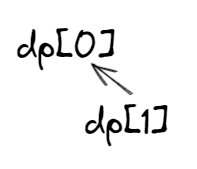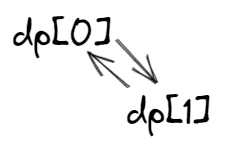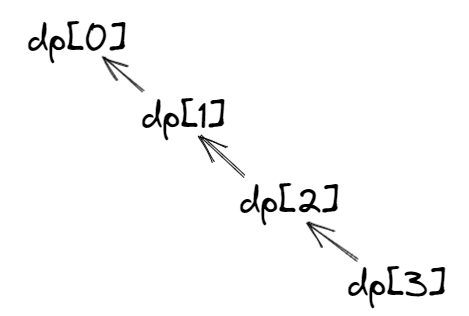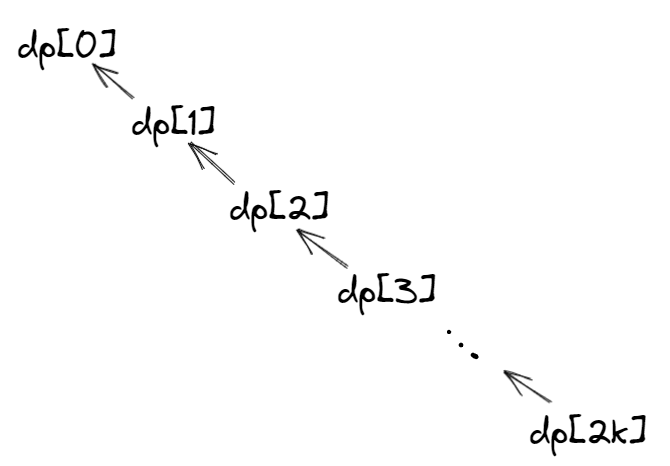动态规划股票问题总结
以下题目均使用动态规划进行解答,当然对于前两题直接贪心是没问题的。
- 买卖股票的最佳时机
- 买卖股票的最佳时机 II
- 买卖股票的最佳时机 III
- 买卖股票的最佳时机 IV
- 最佳买卖股票时机含冷冻期
- 买卖股票的最佳时机含手续费
题目详解
dp数组每一个元素的值表示当前状态的利益,更新时,选择利益最大化的操作来更新状态。
例如:
买卖股票的最佳时机
| 题目类型 | 1次 |
|---|---|
| dp数组长度 | 2 |
| dp含义 | dp0:未持有股票 dp1:持有股票 |
| dp状态转移 | dp0每次都是第一次买,所以无需考虑之前如果卖出的状态。 而dp1是卖出,所以一定依赖于dp0持有时的状态。 |
dp0:之前持有股票的利益为dp0,当天购买利益为-prices[i]。
dp1:之前未持有股票(有可能是卖了或没买)的利益为dp1,今天卖的利益为dp0 + prices[i]
class Solution {
public int maxProfit(int[] prices) {
if(prices.length == 0) return 0;
int dp0 = -prices[0];
int dp1 = 0;
for(int i = 1;i < prices.length; i++){
dp0 = Math.max(dp0,-prices[i]);
dp1 = Math.max(dp1,dp0 + prices[i]);
}
return dp1;
}
}
依赖关系:

买卖股票的最佳时机 II
| 题目类型 | 无限次 |
|---|---|
| dp数组长度 | 2 |
| dp含义 | dp0:未持有股票 dp1:持有股票 |
| dp状态转移 | dp0每次不一定第一次买,所以需要考虑之前如果卖出的状态(dp1)。 而dp1是卖出,所以一定依赖于dp0持有时的状态。 |
dp0:之前持有股票的利益为dp0,当天购买利益为**dp1 **- prices[i]。(无限次购买,需要之前未持有的状态,依赖dp1)
dp1:之前未持有股票(有可能是卖了或没买)的利益为dp1,今天卖的利益为dp0 + prices[i](需要保证昨天持有,依赖于状态dp0)
class Solution {
public int maxProfit(int[] prices) {
int[] dp = new int[2];
// 0表示持有,1表示卖出
dp[0] = -prices[0];
dp[1] = 0;
for(int i = 1; i < prices.length; i++){
// 前一天持有; 既然不限制交易次数,那么再次买股票时,要加上之前的收益
dp[0] = Math.max(dp[0], dp[1] - prices[i]);
// 前一天卖出; 或当天卖出,当天卖出,得先持有
dp[1] = Math.max(dp[1], dp[0] + prices[i]);
}
return dp[1];
}
}
依赖关系:

买卖股票的最佳时机含手续费
| 题目类型 | 无限次 |
|---|---|
| dp数组长度 | 2 |
| dp含义 | dp0:未持有股票 dp1:持有股票 |
和上一题相比,执行购买操作时加上手续费即可。
class Solution {
public int maxProfit(int[] prices,int fee) {
int[] dp = new int[2];
// 0表示持有,1表示卖出
dp[0] = -prices[0] - fee;
dp[1] = 0;
for(int i = 1; i < prices.length; i++){
// 前一天持有; 既然不限制交易次数,那么再次买股票时,要加上之前的收益
dp[0] = Math.max(dp[0], dp[1] - prices[i] - fee);
// 前一天卖出; 或当天卖出,当天卖出,得先持有
dp[1] = Math.max(dp[1], dp[0] + prices[i]);
}
return dp[1];
}
}
依赖关系:

买卖股票时机含冷冻期
| 题目类型 | 无限次 + 冷冻期 |
|---|---|
| dp数组长度 | 2 |
| dp含义 | dp0:未持有股票 dp1:持有股票 |
这里只需改变dp0的操作即可,原来的操作为:
dp0 = Math.max(昨天的dp0, 昨天的dp1 - prices[i]);
现在改为
dp0 = Math.max(昨天的dp0, **前天**的dp1 - prices[i]);
class Solution
{
public int maxProfit(int[] prices)
{
if (prices.length == 1) {
return 0;
}
int[][] dp = new int[prices.length][2];
dp[0][0] = -prices[0];
dp[0][1] = 0;
dp[1][0] = Math.max(-prices[0], -prices[1]);
dp[1][1] = Math.max(0, dp[0][0] + prices[1]);
for (int i = 2; i < prices.length; i++) {
dp[i][0] = Math.max(dp[i - 1][0], dp[i - 2][1] - prices[i]);
dp[i][1] = Math.max(dp[i - 1][1], dp[i - 1][0] + prices[i]);
}
return dp[prices.length - 1][1];
}
}
依赖关系:

买卖股票的最佳时机 III
| 题目类型 | 2次 |
|---|---|
| dp数组长度 | 4 |
| dp含义 | dp0:第一次持有股票 dp1:未持有股票(已经卖了一次) dp2:第二次持有股票 dp3:未持有股票(已经卖了两次) |
| dp状态转移 | 同之前的题目,dp0这次的状态,直接定义为第一次买,所以无需考虑其他状态。 剩下的状态都会与上一个装填有所关联,所以依次依赖。 |
class Solution {
public int maxProfit(int[] prices) {
int[] dp = new int[4];
// 1 持有
// 2 持有后卖出
// 3 持有后卖出 再持有
// 4 持有后卖出 再持有再卖出
dp[0] = -prices[0];
dp[2] = -prices[0];
for (int i = 1; i < prices.length; i++) {
dp[0] = Math.max(dp[0], -prices[i]);
dp[1] = Math.max(dp[1], dp[0] + prices[i]);
dp[2] = Math.max(dp[2], dp[1] - prices[i]);
dp[3] = Math.max(dp[3], dp[2] + prices[i]);
}
return dp[3];
}
}
依赖关系:

买卖股票的最佳时机 VI
| 题目类型 | k次 |
|---|---|
| dp数组长度 | 2 * k |
| dp含义 | dp0:第一次持有股票 dp1:未持有股票(已经卖了一次) dp2:第二次持有股票 dp3:未持有股票(已经卖了两次) dp4:第三次持有股票 依次类推 |
| dp状态转移 | 同之前的题目,dp0这次的状态,直接定义为第一次买,所以无需考虑其他状态。 剩下的状态都会与上一个装填有所关联,所以依次依赖。 |
class Solution {
public int maxProfit(int k, int[] prices) {
int[] dp = new int[2 * k];
for (int i = 0; i < dp.length; i += 2) {
dp[i] = -prices[0];
}
for (int i = 1; i < prices.length; i++) {
for (int j = 0; j < dp.length; j++) {
int prevStatus = j - 1 >= 0 ? dp[j - 1] : 0;
dp[j] = Math.max(dp[j], prevStatus + prices[i] * (j % 2 == 0 ? -1 : 1));
}
}
return dp[dp.length - 1];
}
}
依赖关系:



 浙公网安备 33010602011771号
浙公网安备 33010602011771号